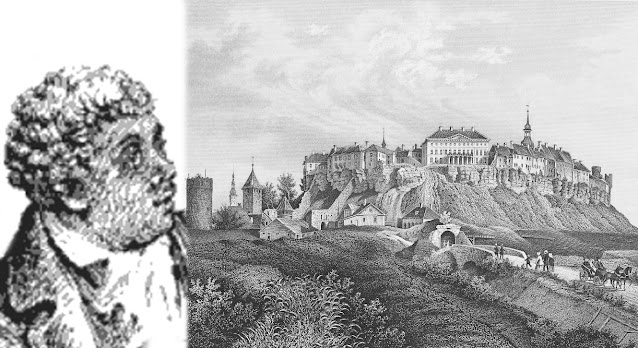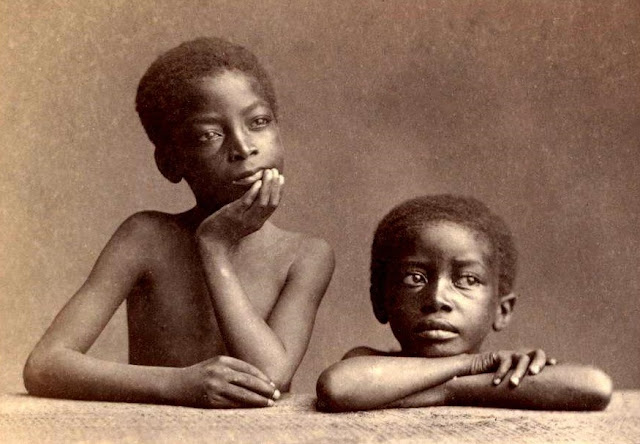The African Governor and Guardian of Estonia's Capital City
The African Governor and Guardian of Estonia's Capital City
 |
| Left: Portrait of Gannibal from Illustrated Naval and Military Magazine, Volume 8 (1888); Right: Engraving of Reval (Tallinn) in 1867 by Wilhelm Siegfried Stavenhagen (Source: Wikipedia Commons) |
Pictured below is the house where the African prince and Russian nobleman Abraham Gannibal (c. 1696-1781) lived as the chief commandant of what is now Estonia's largest city, Tallinn. Revel (Tallinn's old name) and its fortress were established at the end of the 10th century, then taken by the Danes in the early 13th century. Later, Reval was ruled by the Germans and Swedes. Reval was then conquered by Russian emperor Peter the Great in 1710. For 10 years - from 1742 to 1752 - Gannibal served as the de-facto governor of that historic city.
 |
| House of the military commander of Reval (now Tallinn) Photo by Wikipedia user Elin Galtung Lihaug |
The photo above was taken in 2003. As these photos show, the house received a complete makeover since then. Plans to repair the structure began in 2006. The new coat of paint was added in 2009 when most of the inner and outer restorations took place.
 |
| Photo by Wikipedia user Lefevrue |
 |
| Photo by Wikipedia user Dilas25 |
 |
| Photo by Wikipedia user Geonarva |
The building was officially registered as a national monument of Estonia on April 15, 1997. That same year, most of historic Tallinn was included in the United Nations Educational, Scientific, and Cultural Organization (UNESCO)'s list of world heritage sites.
A sign on the building says: "In this building lived in 1742-1752 the great grandfather of A. S. Pushkin, Abram Petrovich Hannibal (1696-1781)." Pushkin's grandfather was actually born there.
 |
| The house of the military commander of Reval (now Tallinn) Photo by Wikipedia User Elin Galtung Lihaug |
The commandant's house was built adjacent to Toompea Castle at the main gate. This castle is still located in the center of Tallinn.
The website for Tallinn's official city guide has this to say about the castle:
Perched on a limestone cliff and towering over the rest of the city, Toompea Castle has always been the seat of power in Estonia.
In the time of Danish rule in Reval, the smaller part of the fortress, where the commandant's house stands, was the center of influence for the secular Estonian rulers, while the Catholic Danes governed from the larger portion. A similar arrangement was maintained under Swedish rule.
For much of the later periods, this area continued to be reserved for administrative purposes. The Russian research site Средневековые замки и крепости мира ("Medieval castles and fortresses of the world") specifies that this was the case from 1691 onwards and that after the city was seized in 1710, the fortress itself had fallen into great disrepair. From this, we can only assume that by the time Gannibal was at the helm of leadership within the fortress, there was nothing to command but the city itself. For many years, Reval had been ruled by its own Town Council, comprised of an elite class. After the devastation of war, which cut its population to a fifth of its original size, this small town of 2,000 was held subject to the paw of Russia.
 |
| Portrait of Peter August Friedrich 18th Century (Source: Wikipedia Commons) |
Then governor-general of Reval, Peter August Friedrich (1696-1775), was Russia's local political watchdog from 1743 to 1753. Count Johann Burckhardt Christopher Minich, a high-ranking officer in the Russian military, called his subordinate, Friedrich, a 'poor' man who 'does not have great gifts; misbehaves; [and] finds it difficult to command, not knowing Russian.'
Gannibal, a war hero and a gentleman, was well respected wherever he went. If not for these attributes in light of his colleague's shortcomings, Gannibal might have been little more than a figurehead in Reval, guarding the city from the Swedes and monitoring the political landscape for signs of revolt. But Gannibal was a capable representative of the Russian crown. His own office gave him the ultimate word in all proceedings pertaining to the security of its denizens.
After Gannibal's reign, the fortress remained a seat of power in Reval.
In 1766, Empress Catherine II ordered that the castle be transformed into the residence of the governor-general of Estonia. Over the next seven years, from 1767 to 1773, governors of Estonia lived in a palace constructed by architect Johann Schulz within the fortress. Today, this palace is the site of the nation's parliament.
 |
| Bust of Gannibal in Petrovsky Park Photo by Wikipedia User Ludushka |
Pushkin was a prolific writer and is widely regarded as Russia's greatest poet. Both Gannibal and Pushkin considered themselves Black men. I think that is powerful.
| Here are some pictures of what the city of Tallinn and its fortress look like today... |
 |
| Tallinn panorama Photo by Flickr user olgite |
 |
| Photo by Kaupo Kalda (Source: Wikipedia Commons) |
 |
| View of Toompea castle from the northeast Photo by Wikipedia user Hannu |
 |
| Photo by Kaupo Kalda (Source: Wikipedia Commons) |
 |
| Photo by Kaupo Kalda (Source: Wikipedia Commons) |
 |
| Estonian Parliament building Photo by Wikipedia user Nikater |
 |
| Formal sitting of the club and the Estonian parliament in Tallinn on August 20, 2016 during ceremonial events in honor of the 25th anniversary of the restoration of Estonia's independence Photo by Juris Vīgulis/Saeima Administration via Flickr |
One of the most interesting sites in Tallinn is the building which served as the headquarters for a guild of unmarried craftsmen and merchants called the Brotherhood of the Blackheads. This club dates back to the 14th century. Notable members included Russian monarchs Peter I, Nicholas I, and Alexander I.
 |
| Main facade of the Brotherhood of the Blackheads building in Tallinn Photo by Wikipedia user China Crisis |
And look who greeted them all at the door - a Black man!
 |
| Entrance to the House of the Blackheads Photo by Wikipedia User Brunswick |
 |
| Detail above the entrance to the House of the Brotherhood of the Black Heads, Tallinn, Estonia Photo by Wikipedia user Klarqa |
According to Estonia's National Heritage Board, the image represents the coat of arms for the 'Brotherhood of St. Mauritius,' and was probably added there in 1597.
- Omri C.



Comments
Post a Comment